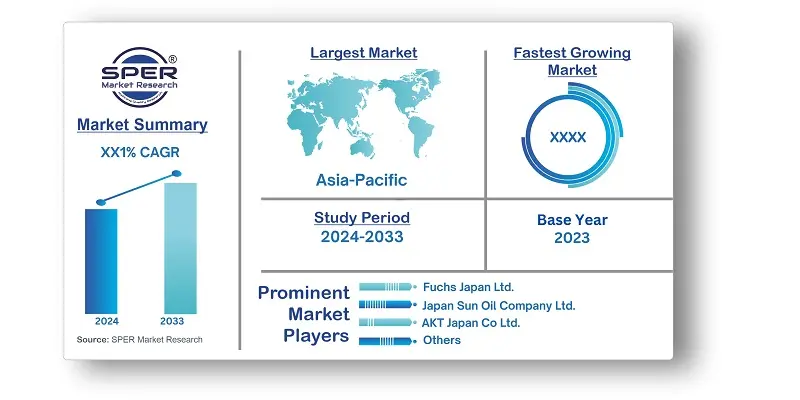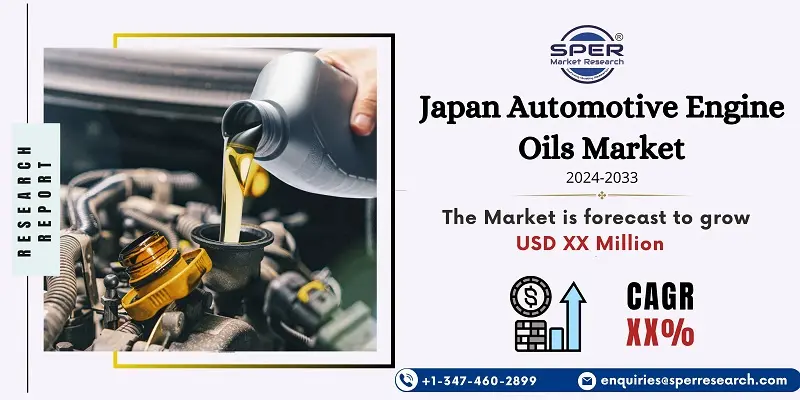
Japan Automotive Engine Oils Market Growth, Size, Trends, Share, Revenue and future Outlook
Japan Automotive Engine Oils Market Size– By Grade, By Engine Type, By Vehicle Type- Regional Outlook, Competitive Strategies and Segment Forecast to 2033
| Published: Aug-2024 | Report ID: AMIN24182 | Pages: 1 - 108 | Formats*: |
| Category : Automotive & Transportation | |||
- January 2022: Effective April 1, ExxonMobil Corporation was divided into three business lines: ExxonMobil Upstream Company, ExxonMobil Product Solutions, and ExxonMobil Low Carbon Solutions.
- April 2021: Motul introduced two engine oils for antique cars built between the 1970s and 2000s: antique EIGHTIES 10W-40 and CLASSIC NINETIES 10W-30.
- March 2021: Motul engineers collaborate with Honda's HRC factory racing team's engine development department on several initiatives, including the production of high-tech synthetic lubricants, at the company's R&D centre in Japan.


| Report Metric | Details |
| Market size available for years | 2020-2033 |
| Base year considered | 2023 |
| Forecast period | 2024-2033 |
| Segments covered | By Grade, By Engine Type, By Vehicle Type |
| Regions covered | Kanto Region, Kinki Region, Central/ Chubu Region, Kyushu-Okinawa Region, Tohoku Region, Chugoku Region, Hokkaido Region, Shikoku Region |
| Companies Covered | Fuchs Japan Ltd, Japan Sun Oil Company Ltd, AKT Japan Co Ltd, Motul, BP PLC (Castrol), Cosmo Energy Holdings Co, Ltd, ENEOS Corporation, ExxonMobil Corporation, Royal Dutch Shell Plc, Idemitsu Kosan Co Ltd. |
- Automobile Owners
- Automobile Manufacturers
- Automotive Dealerships
- Automotive Service Centers and Garages
- Fleet Operators
- Industrial Users
- Retailers and Distributors
- Performance Enthusiasts
| By Grade: |
|
| By Engine Type: |
|
| By Vehicle Type: |
|
- Japan Automotive Engine Oils Market Size (FY’2024-FY’2033)
- Overview of Japan Automotive Engine Oils Market
- Segmentation of Japan Automotive Engine Oils Market By Grade (Mineral, Semi-synthetic, Fully-synthetic)
- Segmentation of Japan Automotive Engine Oils Market By Engine Type (Gasoline, Diesel, Alternative Fuels)
- Segmentation of Japan Automotive Engine Oils Market By Vehicle Type (Passenger Cars, Motorcycle)
- Statistical Snap of Japan Automotive Engine Oils Market
- Expansion Analysis of Japan Automotive Engine Oils Market
- Problems and Obstacles in Japan Automotive Engine Oils Market
- Competitive Landscape in the Japan Automotive Engine Oils Market
- Impact of COVID-19 and Demonetization on Japan Automotive Engine Oils Market
- Details on Current Investment in Japan Automotive Engine Oils Market
- Competitive Analysis of Japan Automotive Engine Oils Market
- Prominent Players in the Japan Automotive Engine Oils Market
- SWOT Analysis of Japan Automotive Engine Oils Market
- Japan Automotive Engine Oils Market Future Outlook and Projections (FY’2024-FY’2033)
- Recommendations from Analyst
1.1. Scope of the report1.2. Market segment analysis
2.1. Research data source2.1.1. Secondary Data2.1.2. Primary Data2.1.3. SPER’s internal database2.1.4. Premium insight from KOL’s2.2. Market size estimation2.2.1. Top-down and Bottom-up approach2.3. Data triangulation
4.1. Driver, Restraint, Opportunity and Challenges analysis4.1.1. Drivers4.1.2. Restraints4.1.3. Opportunities4.1.4. Challenges4.2. COVID-19 Impacts of the Japan Automotive Engine Oils Market.
5.1. SWOT Analysis5.1.1. Strengths5.1.2. Weaknesses5.1.3. Opportunities5.1.4. Threats5.2. PESTEL Analysis5.2.1. Political Landscape5.2.2. Economic Landscape5.2.3. Social Landscape5.2.4. Technological Landscape5.2.5. Environmental Landscape5.2.6. Legal Landscape5.3. PORTER’s Five Forces5.3.1. Bargaining power of suppliers5.3.2. Bargaining power of buyers5.3.3. Threat of Substitute5.3.4. Threat of new entrant5.3.5. Competitive rivalry5.4. Heat Map Analysis
6.1. Japan Automotive Engine Oils Market Manufacturing Base Distribution, Sales Area, Product Type6.2. Mergers & Acquisitions, Partnerships, Product Launch, and Collaboration in Japan Automotive Engine Oils Market
7.1. Japan Automotive Engine Oils Market Size, Share and Forecast, By Grade, 2020-20267.2. Japan Automotive Engine Oils Market Size, Share and Forecast, By Grade, 2027-20337.3. Mineral7.4. Semi-synthetic7.5. Fully-synthetic
8.1. Japan Automotive Engine Oils Market Size, Share and Forecast, By Engine Type, 2020-20268.2. Japan Automotive Engine Oils Market Size, Share and Forecast, By Engine Type, 2027-20338.3. Gasoline8.4. Diesel8.5. Alternative Fuels
9.1. Japan Automotive Engine Oils Market Size, Share and Forecast, By Vehicle Type, 2020-20269.2. Japan Automotive Engine Oils Market Size, Share and Forecast, By Vehicle Type, 2027-20339.3. Passenger Cars9.4. Motorcycle
10.1. Japan Automotive Engine Oils Market Size and Market Share
11.1. Japan Automotive Engine Oils Market Size and Market Share By Region (2020-2026)11.2. Japan Automotive Engine Oils Market Size and Market Share By Region (2027-2033)11.3. Kanto Region11.4. Kinki Region11.5. Central/ Chubu Region11.6. Kyushu-Okinawa Region11.7. Tohoku Region11.8. Chugoku Region11.9. Hokkaido Region11.10. Shikoku Region
12.1. Fuchs Japan Ltd12.1.1. Company details12.1.2. Financial outlook12.1.3. Product summary12.1.4. Recent developments12.2. Japan Sun Oil Company, Ltd12.2.1. Company details12.2.2. Financial outlook12.2.3. Product summary12.2.4. Recent developments12.3. AKT Japan Co. Ltd12.3.1. Company details12.3.2. Financial outlook12.3.3. Product summary12.3.4. Recent developments12.4. Motul12.4.1. Company details12.4.2. Financial outlook12.4.3. Product summary12.4.4. Recent developments12.5. BP PLC (Castrol)12.5.1. Company details12.5.2. Financial outlook12.5.3. Product summary12.5.4. Recent developments12.6. Cosmo Energy Holdings Co Ltd12.6.1. Company details12.6.2. Financial outlook12.6.3. Product summary12.6.4. Recent developments12.7. ENEOS Corporation12.7.1. Company details12.7.2. Financial outlook12.7.3. Product summary12.7.4. Recent developments12.8. ExxonMobil Corporation12.8.1. Company details12.8.2. Financial outlook12.8.3. Product summary12.8.4. Recent developments12.9. Royal Dutch Shell Plc12.9.1. Company details12.9.2. Financial outlook12.9.3. Product summary12.9.4. Recent developments12.10. Idemitsu Kosan Co. Ltd12.10.1. Company details12.10.2. Financial outlook12.10.3. Product summary12.11. Others12.10.4. Recent developments
SPER Market Research’s methodology uses great emphasis on primary research to ensure that the market intelligence insights are up to date, reliable and accurate. Primary interviews are done with players involved in each phase of a supply chain to analyze the market forecasting. The secondary research method is used to help you fully understand how the future markets and the spending patterns look likes.
The report is based on in-depth qualitative and quantitative analysis of the Product Market. The quantitative analysis involves the application of various projection and sampling techniques. The qualitative analysis involves primary interviews, surveys, and vendor briefings. The data gathered as a result of these processes are validated through experts opinion. Our research methodology entails an ideal mixture of primary and secondary initiatives.



Frequently Asked Questions About This Report
PLACE AN ORDER
Year End Discount
Sample Report
Pre-Purchase Inquiry
NEED CUSTOMIZATION?
Request CustomizationCALL OR EMAIL US
100% Secure Payment






Related Reports
Our Global Clients
Our data-driven insights have influenced the strategy of 200+ reputed companies across the globe.




















